General Principles for Approaches to the Facial Skeleton - part 8 ppsx
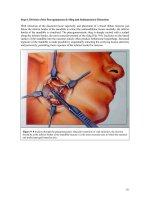
General Principles for Approaches to the Facial Skeleton - part 8 ppsx
... inferior to the lowest part of
the bony external auditory meatus (Fig. 1 0-1 ). The average distance from the lowest point on the
external bony auditory meatus to the bifurcation of the facial ... laterally into the substance of
the parotid gland. The length of the facial nerve trunk that is visible to the surgeon is about 1,3 cm.
It divides into the...
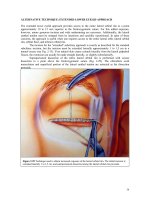
General Principles for Approaches to the Facial Skeleton - part 3 pdf
... just
posterior to the orbital septum, ending just posterior to the orbital rim (Fig. 3 -8 ).
Figure 3 8 Scissors placed into the initial canthopexy incision to dissect in the subconjunctival plane. The
dissection ... superior limb of the tendon. An effective
method to pass this suture is to identify the superior limb of the canthal tendon first with small,
toothed...

General Principles for Approaches to the Facial Skeleton - part 4 doc
... 6-4 Branches
of the facial nerve.
The distance from
the anterior
concavity of the
external auditory
canal to the crossing
of the zygomatic
arch (arrow) by the
temporal branch
varies from 8 to ... of Facial Nerve
The temporal branches of the facial nerve are often called the frontal branches when they reach the
supraciliary region. The nerves provide motor...
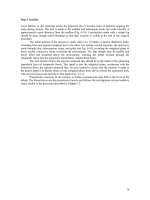
General Principles for Approaches to the Facial Skeleton - part 5 pot
... the periosteum of the nasofrontal region (see Fig.
6-1 7). Dissection can proceed along the dorsum to the nasal tip, if necessary (Fig. 6-1 8) .
Figure 6-1 8 Dissection inferiorly to the top of the ... across the forehead from one superior temporal line to
the other. The tension throu
g
h
p
eriosteum should be 3 to 4 cm su
p
erior to the orbital rims....
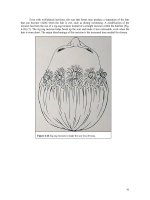
General Principles for Approaches to the Facial Skeleton - part 6 pot
... effect
of the medial pull of the alar bases on the nose (Fig. 7-7 ). Another method is to evert the tissue into
the incision area by pressing the thumb or finger into the alar facial groove (Fig. 7 -8 ). ... relationship of facial vessels to
b
one. The onl
y
tissue between them is the
p
eriosteum.
S E C T I O N
IV
TRANSORAL
APPROACHES TO THE
FACIAL SK...
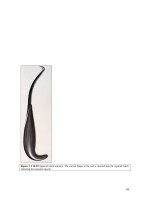
General Principles for Approaches to the Facial Skeleton - part 9 docx
...
anterior (2 mm) bands. The upper surface of the disk adapts to the contours of the fossa and
eminence of the temporal bone, and the lower surface of the disk adapts to the contour of the
mandibular ... individual to the next, and
range anywhere from 8 to 35 mm (20 mm average) anterior to the external auditory canal (Fig.
1 2-2 ) (1). Therefore, protect...

General Principles for Approaches to the Facial Skeleton - part 10 pps
... the hair out of the
surgical field. Cotton soaked in mineral oil or antibiotic ointment may be placed into the
external auditory canal.
1 68
ALTERNATE APPROACHES
Other approaches to ... freeing the
periosteum from its lateral surface. The periosteal elevator can then be used to continue bluntly
dissecting inferiorly with the black-and-forth motion, taking ca...
Từ khóa:
- the complete guide to the toefl ibt part 8 docx
- theoretical approaches to the globalised age
- approaches to the critique of auditing
- experimental approaches to the study of polymer adsorption
- an overview of approaches to the causes of mobility disability
- general principles and applications to dairy manure in new york
- log method that extracts all the information to log and then calls the logwrite for saving to the database
- global experiences and innovative approaches to the diagnosis
- resolutions for loans to the corporation
- practical approaches to the management of superficial bladder cancer
- behaviour genetic approaches to the study of adhd
- nmr approaches to the heat cold and pressure induced unfolding of proteins
- 10 new approaches to the late events of therapy
- surgical approaches to the heart and great vessels
- surgical approaches to the spine
- Báo cáo thực tập tại nhà thuốc tại Thành phố Hồ Chí Minh năm 2018
- Nghiên cứu sự hình thành lớp bảo vệ và khả năng chống ăn mòn của thép bền thời tiết trong điều kiện khí hậu nhiệt đới việt nam
- Nghiên cứu tổ chức pha chế, đánh giá chất lượng thuốc tiêm truyền trong điều kiện dã ngoại
- Nghiên cứu tổ hợp chất chỉ điểm sinh học vWF, VCAM 1, MCP 1, d dimer trong chẩn đoán và tiên lượng nhồi máu não cấp
- Nghiên cứu tổ chức chạy tàu hàng cố định theo thời gian trên đường sắt việt nam
- Giáo án Sinh học 11 bài 13: Thực hành phát hiện diệp lục và carôtenôit
- ĐỒ ÁN NGHIÊN CỨU CÔNG NGHỆ KẾT NỐI VÔ TUYẾN CỰ LY XA, CÔNG SUẤT THẤP LPWAN
- Phát triển mạng lưới kinh doanh nước sạch tại công ty TNHH một thành viên kinh doanh nước sạch quảng ninh
- Trả hồ sơ điều tra bổ sung đối với các tội xâm phạm sở hữu có tính chất chiếm đoạt theo pháp luật Tố tụng hình sự Việt Nam từ thực tiễn thành phố Hồ Chí Minh (Luận văn thạc sĩ)
- Phát hiện xâm nhập dựa trên thuật toán k means
- Nghiên cứu, xây dựng phần mềm smartscan và ứng dụng trong bảo vệ mạng máy tính chuyên dùng
- Nghiên cứu tổng hợp các oxit hỗn hợp kích thƣớc nanomet ce 0 75 zr0 25o2 , ce 0 5 zr0 5o2 và khảo sát hoạt tính quang xúc tác của chúng
- Nghiên cứu khả năng đo năng lượng điện bằng hệ thu thập dữ liệu 16 kênh DEWE 5000
- Định tội danh từ thực tiễn huyện Cần Giuộc, tỉnh Long An (Luận văn thạc sĩ)
- Tổ chức và hoạt động của Phòng Tư pháp từ thực tiễn tỉnh Phú Thọ (Luận văn thạc sĩ)
- Quản lý nợ xấu tại Agribank chi nhánh huyện Phù Yên, tỉnh Sơn La (Luận văn thạc sĩ)
- BT Tieng anh 6 UNIT 2
- Tăng trưởng tín dụng hộ sản xuất nông nghiệp tại Ngân hàng Nông nghiệp và Phát triển nông thôn Việt Nam chi nhánh tỉnh Bắc Giang (Luận văn thạc sĩ)
- Giáo án Sinh học 11 bài 15: Tiêu hóa ở động vật
- Giáo án Sinh học 11 bài 14: Thực hành phát hiện hô hấp ở thực vật